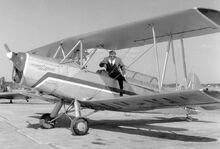VL Viima (Cold Wind), also known as Valmet Viima after 1951, is a Finnish two-seat training biplane produced by the Valtion lentokonetehdas (VL, State Aircraft Factory) from 1936 to 1939 and used by the Finnish Air Force from 1939 to 1962. After their retirement, ten were sold to civilian buyers.
Development[]

The sole Viima IIB, OH-VIA, in the early 1960s.
The Viima was designed in 1934-1935 to replace the aging Letov Š-218As, and the FAF ordered a prototype in February 1935. It was built quickly and made its maiden flight on 11 January 1936 at Laajalahti, carrying the registration code VI-1. Its rudder and ailerons were found to be ineffective while the horizontal stabilisers were overly sensitive, and so modifications were made.
In 1937 the prototype version, Viima I, was replaced by the Viima II with a shallower fuselage, a new airfoil, and without the central fuel tank. The Viima II first flew on 12 October 1937 and proved to be superior to the Viima I, and comparable to the Bücker Bü 131.
The FAF ordered 20 Viimas on 4 June 1938, and they were delivered in 1939. Two Viimas were given the civilian registration codes OH-ILM and OH-ILN, despite being used by the FAF.
The FAF ordered 16 more Viimas in 1941, but cancelled the order the next year, since the more advanced VL Tuuli I trainer intended to replace the Viima was already taking shape, and the availability of Viima's Siemens-Halske Sh 14 engines was poor.
One Viima II was fitted with a de Havilland Gipsy Major engine and a streamlined engine cowling. It was known as the Viima IIB.
Service[]
The Viimas mainly served as trainers, as intended to, but some were used as "station hacks". They logged a total of ca. 78,000 flying hours, and suffered nine fatal accidents with 11 fatalities. In the 1950s the Viimas were modified by fitting them with an enclosed cockpit, moving the pilot's position from rear to front, widening the fuselage and extending the engine mount by 10 cm. The last Viima flight in FAF service was made by VI-21 on 17 August 1962.
Ten Viimas were sold to civilian buyers and used by flying clubs, most importantly as glider tugs.
Survivors[]
- OH-VII (formerly VI-21) is at the Finnish Aviation Museum in Vantaa. It was de-registered in 1989 and was the last flying Viima at the time.
- The prototype VI-1 is on display at Härmälä in Tampere, near the former VL aircraft factory.
- OH-VIF (formerly VI-17) is flying in post-war FAF colours.
- The first Viima II, OH-VIG (formerly VI-3 and D-EVVI) is flying in World War II FAF colours. It was bought back from Germany in 2015.
Construction[]
The Viima has a chrome-molybdenium steel fuselage covered with fabric. The wingspan is unequal.
Variants[]
- VL Viima I – three prototypes.
- VL Viima II – upgraded serial production version, 20 built.
- VL Viima IIB – experimental version of the Viima II with a de Havilland Gipsy Major inline engine, one built.
Specifications (Viima II)[]
- Crew: 2
- Length: 7.35 m (24 ft 1 in)
- Wingspan: 9.20 m (30 ft 2 in)
- Height: 2.73 m (8 ft 11 in)
- Wing area: 20 m2 (220 sq ft)
- Airfoil: NACA 23012
- Empty weight: 555 kg (1,224 lb)
- Gross weight: 875 kg (1,929 lb)
- Powerplant: 1 × Siemens-Halske Sh 14A 7-cylinder single row radial, air cooled, 110 kW (150 hp)
- Maximum speed: 186 km/h (116 mph, 100 kn)
- Cruise speed: 167 km/h (104 mph, 90 kn)
- Range: 500 km (310 mi, 270 nmi)
- Service ceiling: 3,700 m (12,100 ft)
- Time to altitude: 15 min to 2000 m
- Wing loading: 44 kg/m2 (9.0 lb/sq ft)